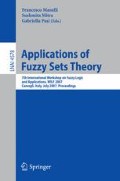Abstract
We present a method to recognize the presence of lung cancer in individuals by classifying the olfactory signal acquired through an electronic nose based on an array of MOS sensors. We analyzed the breath of 101 persons, of which 58 as control and 43 suffering from different types of lung cancer (primary and not) at different stages. In order to find the components able to discriminate between the two classes ‘healthy’ and ‘sick’ as best as possible and to reduce the dimensionality of the problem, we extracted the most significative features and projected them into a lower dimensional space, using Nonparametric Linear Discriminant Analysis. Finally, we used these features as input to a pattern classification algorithm, based on Fuzzy k-Nearest Neighbors (Fuzzy k-NN). The observed results, all validated using cross-validation, have been satisfactory achieving an accuracy of 92.6%, a sensitivity of 95.3% and a specificity of 90.5%. These results put the electronic nose as a valid implementation of lung cancer diagnostic technique, being able to obtain excellent results with a non invasive, small, low cost and very fast instrument.
Access this chapter
Tax calculation will be finalised at checkout
Purchases are for personal use only
Preview
Unable to display preview. Download preview PDF.
References
Gardner, J.W., Bartlett, P.N.: Electronic noses. Principles and applications. Oxford University Press, Oxford (1999)
Osuna, R.G., Nagle, H.T., Shiffman, S.S.: The how and why of electronic nose, IEEE Spectrum, pp. 22–34 (September 1998)
Pardo, M., Sberveglieri, G.: Electronic Olfactory Systems Based on Metal Oxide Semiconductor Sensor Arrays. Material Research Society Bullettin 29(10) (October 2004)
Di Natale, C., Macagnano, A., Martinelli, E., Paolesse, R., D’Arcangelo, G., Roscioni, C., Finazzi-Agro, A., D’Amico, A.: Lung cancer identification by the analysis of breath by means of an array of non-selective gas sensors. Biosensors and Bioelectronics 18(10), 1209–1218 (2003)
Machado, R.F., Laskowski, D., Deffenderfer, O., Burch, T., Zheng, S., Mazzone, P.J., Mekhail, T., Jennings, C., Stoller, J.K., Pyle, J., Duncan, J., Dweik, R.A., Erzurum, S.: Detection of Lung Cancer by Sensor Array Analyses of Exhaled Breath, American Journal of Respiratory and Critical Care Medicine. American Journal of Respiratory and Critical Care Medicine 171, 1286–1291 (2005)
Chen, X., Cao, M., Li, Y., Hu, W., Wang, P., Ying, K., Pan, H.: A study of an electronic nose for detection of lung cancer based on a virtual SAW gas sensors array and imaging recognition method. Measurement science & technology 16(8), 1535–1546 (2005)
Phillips, M.D., Cataneo, R.N., Cummin, A.R.C., Gagliardi, A.J., Gleeson, K., Greenberg, J., Maxfield, R.A., Rom, W.N.: Detection of lung cancer with volatile markers in the breath. Chest 123(6), 2115–2123 (2003)
Martinelli, E., Falconi, C., D’Amico, A., Di Natale, C.: Feature Extraction of chemical sensors in phase space. Sensors and Actuators B:Chemical 95(1), 132–139 (2003)
Pieterman, R.M., Van Putten, J.W.G., Meuzelaar, J.J., Mooyaart, E.L., Vaalburg, W., Koter, G.H., Fidler, V., Pruim, J., Groen, H.J.M.: Preoperative staging of non-small-cell lung cancer with positron-emission tomography. The New England journal of medicine 343(4), 254–261 (2000)
Fukunaga, K.: Introduction to statistical pattern recognition, 2nd edn. Academic Press, San Diego (1990)
Lyman Ott, R., Longnecker, M.T.: An Introduction to Statistical Methods and Data Analysis, 5th edn., Duxbury Press (2001)
Fukunaga, K., Mantock, J.M.: Nonparametric discriminant analysis. IEEE Transactions on pattern analysis and machine intelligence PAMI 5(6), 671–678 (1983)
Zadeh, L.: Fuzzy sets. Information and Control 8, 338–353 (1965)
Keller, J.M., Gray, M.R., Givens, J.A.: A fuzzy k-Nearest neighbor algorithm. IEEE Transactions on systems, man and cybernetics 15(4), 580–585 (1985)
Author information
Authors and Affiliations
Editor information
Rights and permissions
Copyright information
© 2007 Springer-Verlag Berlin Heidelberg
About this paper
Cite this paper
Blatt, R., Bonarini, A., Calabró, E., Della Torre, M., Matteucci, M., Pastorino, U. (2007). Fuzzy k-NN Lung Cancer Identification by an Electronic Nose. In: Masulli, F., Mitra, S., Pasi, G. (eds) Applications of Fuzzy Sets Theory. WILF 2007. Lecture Notes in Computer Science(), vol 4578. Springer, Berlin, Heidelberg. https://doi.org/10.1007/978-3-540-73400-0_32
Download citation
DOI: https://doi.org/10.1007/978-3-540-73400-0_32
Publisher Name: Springer, Berlin, Heidelberg
Print ISBN: 978-3-540-73399-7
Online ISBN: 978-3-540-73400-0
eBook Packages: Computer ScienceComputer Science (R0)

